Plot
In Quebec, a tribe of Algonquian agree in exchange for muskets to guide the "Black Robe" (Father Laforgue) and his 20-year-old French assistant, Daniel Davost, for a few weeks upriver to a spot beyond a set of rapids. There, Father Laforgue travels onward to the Huron village of Ihonatiria [2] where a Jesuit mission is already established.
Along the way, Father Laforgue falls under suspicion of being a demon, and his attempts to baptize (convert) his Algonquian guides are unsuccessful. He is captured by unfriendly Iroquois, who torture him, but he escapes and eventually arrives at the fever-ridden Huron village. In exchange for promising them a "water cure" for their sickness, the Hurons agree to be baptized.
Reception
Writing in The New York Times , novelist James Carroll described Black Robe as "an extraordinary novel... in which Brian Moore has brought vividly to life a radically different world and populated it with men and women wholly unlike us. His novel's achievement, however, is that, through the course of its shocking narrative... we recognize its fierce, awful world as the one we live in. We put Mr. Moore's novel down and look at ourselves and our places differently". [1]
Anstiss Drake in the Chicago Tribune praises the novel's "economy of style, vivid characterizations, spellbinding story and a master's touch... He accomplishes a portrait of native tribespeople that is acute and unsentimental. In Laforgue, Moore gives us a type seldom seen nowadays; he has saintly purity and heroism. Laforgue suffers in both mind and spirit on his quest; for his God he walks into a wilderness from which he will never return". [4]

The Wyandot people are an Indigenous peoples of the Northeastern Woodlands of the present-day United States and Canada. Their Wyandot language belongs to the Iroquoian language family.
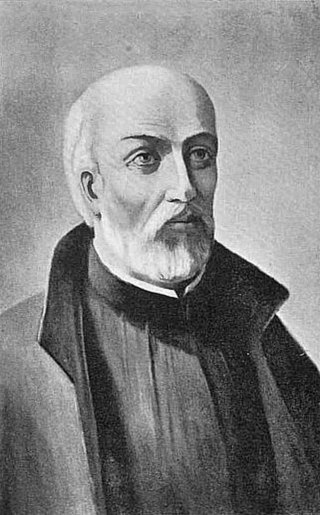
Jean de Brébeuf was a French Jesuit missionary who travelled to New France (Canada) in 1625. There he worked primarily with the Huron for the rest of his life, except for a few years in France from 1629 to 1633. He learned their language and culture, writing extensively about each to aid other missionaries.

Jacques Marquette, S.J., sometimes known as Père Marquette or James Marquette, was a French Jesuit missionary who founded Michigan's first European settlement, Sault Sainte Marie, and later founded Saint Ignace. In 1673, Marquette, with Louis Jolliet, an explorer born near Quebec City, was the first European to explore and map the northern portion of the Mississippi River Valley.
Médard Chouart des Groseilliers was a French explorer and fur trader in Canada. He is often paired with his brother-in-law Pierre-Esprit Radisson, who was about 20 years younger. The pair worked together in fur trading and exploration. Their decision to enter British service led to the foundation of the Hudson's Bay Company in 1670. This company established trading posts and extensive relations with the First Nations in western Canada. It was highly influential in making the region amenable to British colonization. Radisson, with Groseiliers, also mapped many of the Great Lakes and trading routes used by settlers.

Brian Moore, was a novelist and screenwriter from Northern Ireland who emigrated to Canada and later lived in the United States. He was acclaimed for the descriptions in his novels of life in Northern Ireland during and after the Second World War, in particular his explorations of the inter-communal divisions of The Troubles, and has been described as "one of the few genuine masters of the contemporary novel". He was awarded the James Tait Black Memorial Prize in 1975 and the inaugural Sunday Express Book of the Year award in 1987, and he was shortlisted for the Booker Prize three times. Moore also wrote screenplays and several of his books were made into films.
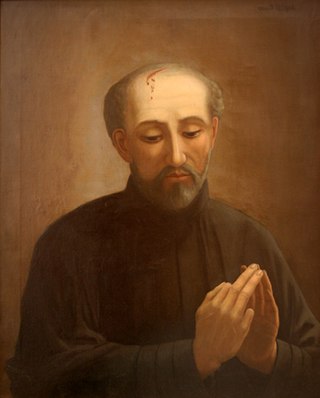
Isaac Jogues was a French missionary and martyr who traveled and worked among the Iroquois, Huron, and other Native populations in North America. He was the first European to name Lake George, calling it Lac du Saint Sacrement. In 1646, Jogues was martyred by the Mohawk at their village of Ossernenon, near the Mohawk River.
The "Huron Carol" is a Canadian Christmas hymn, written probably in 1642 by Jean de Brébeuf, a Jesuit missionary at Sainte-Marie among the Hurons in Canada. Brébeuf wrote the lyrics in the native language of the Huron/Wendat people; the song's original Huron title is "Jesous Ahatonhia". The song's melody is based on a traditional French folk song, "Une Jeune Pucelle". The well-known English lyrics were written in 1926 by Jesse Edgar Middleton and the copyright to these lyrics was held by The Frederick Harris Music Co., Limited, but entered the public domain in 2011.
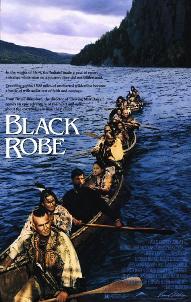
Black Robe is a 1991 historical drama film directed by Bruce Beresford, adapted by Brian Moore from his 1985 novel of the same name. Set in the 17th century, it depicts the adventures of a Jesuit missionary tasked with founding a mission in New France. To do so, he must traverse 1500 miles of harsh wilderness with the help of a group of Algonquins, facing danger from both the unfamiliar environment and rival tribes. The title refers to the nickname given to the Jesuits by the Algonquins, referring to his black cassock.

Jules Laforgue was a Franco-Uruguayan poet, often referred to as a Symbolist poet. Critics and commentators have also pointed to Impressionism as a direct influence and his poetry has been called "part-symbolist, part-impressionist". Laforgue was a model for Pierre-Auguste Renoir, including for Renoir's 1881 painting Luncheon of the Boating Party.
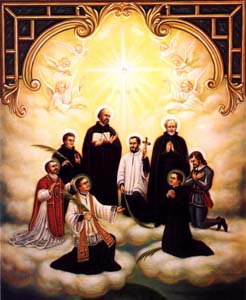
René Goupil,, was a French Jesuit lay missionary who became a lay brother of the Society of Jesus shortly before his death. He was the first of the eight North American Martyrs of the Roman Catholic Church to receive the crown of martyrdom and the first canonized Catholic martyr in North America.

Antoine Daniel was a French Jesuit missionary in North America, at Sainte-Marie among the Hurons, and one of the eight Canadian Martyrs.
Black robe, blackrobe or variant may refer to:
Pierre-Joseph-Marie Chaumonot was a French priest and Jesuit missionary who learned and documented the language of the Wyandot people, also known as the Huron. A series of anonymous manuscript dictionaries of French and Indigenous languages, now preserved at the Musée de la civilisation and the John Carter Brown Library, are traditionally attributed to Chaumonot. He studied at the Jesuits’ noviciate in Florence and, after three more years of training, came to Canada in 1639.
René Ménard was a French Jesuit missionary explorer who traveled to New France in 1641, learned the language of the Wyandot, and was soon in charge of many of the satellite missions around Sainte-Marie among the Hurons. Ménard also worked with the Iroquois, and was said to speak six Indian dialects. He survived the continuous attacks from the Iroquois on the Huron.

Catholics is a novel by Northern Irish-Canadian writer Brian Moore. It was first published in 1972, and was republished in 2006 by Loyola Press with an introduction by Robert Ellsberg and a series of study questions.
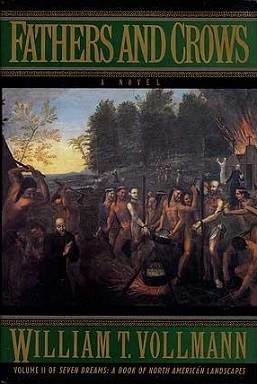
Fathers and Crows is a 1992 historical novel by the American author William T. Vollmann. It is the second book in the seven-book series Seven Dreams: A Book of North American Landscapes.

Jesuit missions in North America were attempted in the late 16th century, established early in the 17th century, faltered at the beginning of the 18th, disappeared during the suppression of the Society of Jesus around 1763, and returned around 1830 after the restoration of the Society. The missions were established as part of the colonial drive of France and Spain during the period, the "saving of souls" being an accompaniment of the constitution of Nouvelle-France and early colonial Mexico. The efforts of the Jesuits in North America were paralleled by their China missions on the other side of the world, and in South America. They left written documentation of their efforts, in the form of The Jesuit Relations.

The Black Robe is an 1881 partially-epistolary novel by famed English writer, Wilkie Collins. The book, which relates the misadventures of one "Lewis Romayne", is noted for its anti-Catholic lens.

The Revolution Script is a fictionalised account by Northern Irish-Canadian novelist Brian Moore of key events in Quebec's October Crisis – the kidnapping by the Quebec Liberation Front of James Cross, the Senior British Trade Commissioner in Montreal, on October 5, 1970 and the murder, a few days later, of Pierre Laporte, Minister of Labour in the Quebec provincial government. It was published in Canada and the United States at the end of 1971. The British newspaper The Sunday Times reproduced excerpts from the book and it was published in the United Kingdom in January 1972.

Camp Ondessonk is an outdoor, Catholic residential youth camp run by the Diocese of Belleville. It is located in the Shawnee National Forest of Southern Illinois, near Ozark, Illinois. The mission of the camp is "Exceptional outdoor and spiritual adventures empowering kids of all ages." Camp Ondessonk is accredited by the American Camp Association.














